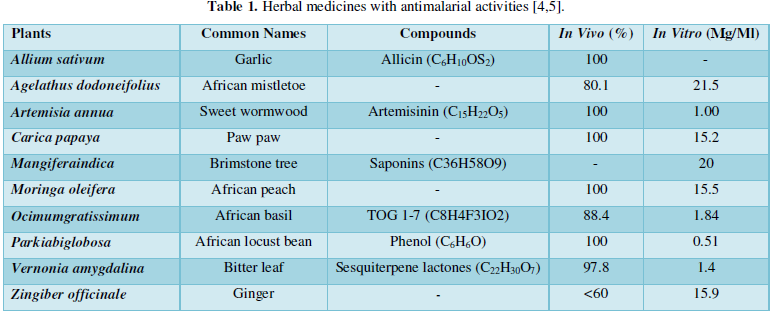Mini-Review
The Efficacy of Herbal Antimalarial Drugs: A Review
3824
Views & Citations2824
Likes & Shares
Herbal medicines have been used to treat malaria for thousands of years in various parts of the world especially Africa as a result of parasite resistance, mosquito vector resistance, non-availability of vaccine and adverse reactions of antimalarial drugs. Thus, malaria is currently a public health problem. In this review, we discuss the in vivo and in vitro antimalarial activities of herbal medicines.
Keywords: Herbal medicines, Malaria, Efficacy, in vivo, in vitro
INTRODUCTION
Malaria remains a public health problem of global concern because of its high economic burden on the nation, high prevalence of mortality in children, pregnant women and non-immune individuals [1]. Strains of P. falciparum have been found to become resistant to the available antimalarial drugs in many endemic areas of the world and many of conventional antimalarial drugs have been associated with treatment failure. In addition to this, the problem of creating efficient vaccines and also adverse side-effects of the existing antimalarial drugs call for the immediate need for novel, well-tolerated antimalarial drugs for both prophylaxis and treatment of malaria [2].
The local traditional medicinal practitioners have managed this debilitating disease in some communities in Africa to reduce excessive mortality due to the disease. The plant kingdom remains a major target in the search of lead compounds and new drugs to treat this king of diseases [3].
This article focuses on antimalarial activity of African herbal medicines with reference to some recent literatures aim at identifying new and effective antimalarial candidates which can be isolated from medicinal plants based on traditional use or ethno medicinal data.
Herbal antimalarial drugs
Traditional medicine practitioners (TMPs) have used plant species from different botanical sources for the treatment and cure of malaria. The first two antimalarial drugs quinine and artemisinin were derived from traditional medicine and plant extracts. The World Health Organization worldwide now recommends Artemisinin derivatives in combination with other drugs, such as lumefantrine, amodiaquine, mefloquine, sulphadoxine-pyrimethamine (SP), as the first-line treatment of malaria [3].
In many developing countries, majority of the populations still use herbal medicines for their health care, people living in rural areas and urban areas depend partly or wholly on traditional medicines. As a result of economic reasons, most of the people in developing countries are prevented from the luxury of access to modern therapy; therefore, people rely on plant and animal resources for their health care over centuries [3].
There are two major steps in the testing of new antimalarial drugs, the first step involves in vitro testing in human, this entails developing assays that focus on the drug’s ability to affect parasite growth in red cells. In these assays, Plasmodium falciparum is the parasite used if the drug is intended for humans, on getting promising results in the in vitro test, then in vivo test can be conducted in the second step of the process, rodents (animal models) are used to test the drug efficacy. In this step, species-specific parasites such as Plasmodium berghei are used [4].
In vivo evaluation of antimalarial compounds begins with the use of rodent malaria parasite because plasmodium species that cause human disease are essentially unable to infect non primate animal models. The preliminary test for the in vivo activity of potential antimalarial agents includes the use of the P. berghei-infected mouse model as it provides a preclinical indication of any in vivo potential bioactivity as well as possible toxicity of the sample tested [4]. The in vitro and in vivo antimalarial activities of some of these herbal medicines are shown in Table 1.


CONCLUSION
Herbal antimalarial drugs continue to be vital in providing antimalarial medicinal compounds and as starting points for the development of antimalarial synthetic analogues. However, there must be adequate information on the contra-indications, drug interactions and toxicities of these drugs as well as proper standardization and clinical trials of these plant products to ensure the safety of these herbal antimalarial drugs.
- Builders MI (2019) Antimalarial phenolic compounds in Africa: A review. Eur J Biomed Pharm Sci 4: 6-11.
- Builders MI (2018) In search of a potent antimalarial agent: Antiplasmodial assessment of three herbs wit folkloric antimalarial claims. Int J Biomed Clin Sci 3: 40-46.
- Builders MI (2017) African traditional antimalarials: A review. Pharm Chem J 4: 87-98.
- Builders MI (2015) Plants as antimalarial drugs: A review. World J Pharm Pharm Sci 8: 1747-1766.
- Okello D, Kang Y (2019) Exploring Antimalarial Herbal Plants across Communities in Uganda Based on Electronic Data. Evid Based Compl Alt Med 1-27.


